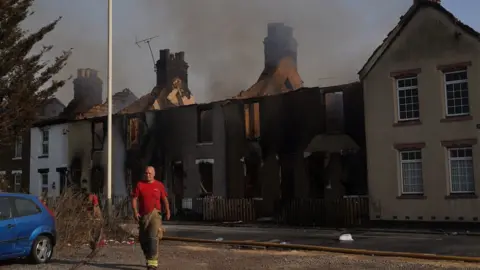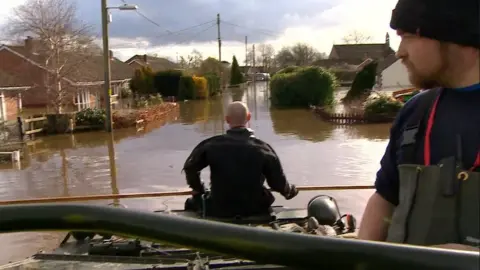Emergency alert system to launch in October across Great Britain
 PA Media
PA MediaAn emergency warning system, allowing alerts about severe weather and other life-threatening events to be sent to mobile phones, will go live in October in England, Scotland and Wales.
The Cabinet Office says the technology will alert up to 85% of the population.
The messages will be sent automatically to any smartphone which is switched on, although it is possible to opt out by changing a mobile phone setting.
Trials of the alerts were held in Reading and East Suffolk this year.
A government publicity campaign will begin in September, and every phone in England, Scotland and Wales, will receive a "welcome message" in October.
The system will eventually cover the whole of the UK, says the government.
The Cabinet Office says the alerts, which will look and sound different to standard messages, will be able to give highly localised warnings of:
- flooding
- fires
- extreme weather
- public health emergencies
Terror attacks could also be added to the list of potential scenarios to trigger a message.
Officials would not discuss the arrangements for warning the population of an impending military or nuclear attack on the country.
Allow Google YouTube content?

About 85% of people have a smartphone capable of receiving the messages, it is estimated.
The government does not have statistics for the number of older 2G and 3G mobile devices in use, and stresses it does not keep a list of all phone users.
The system works by sending a message and a distinctive warning tone to mobiles directly via cell towers, rather than accessing a list of mobile numbers.
An alert can be sent to a single tower, meaning anyone in the vicinity could pick it up, even, for example, when travelling through the area.
The government will draw on the expertise of specialist agencies, such as the Met Office or the Environment Agency, in deciding when to trigger alerts.
The messages can only be sent by the emergency services or the government. Anyone who is concerned that an alert may not be genuine can check on the government website at www.gov.uk/alerts, where all messages will be listed.
Opting out
All phones will be opted into the scheme and users will have to opt out if they don't want the messages - but data from the trials suggests most will not do that.
Touring the Met Office in Exeter on Monday, senior Cabinet Office Minister Kit Malthouse defended the opt-out arrangement.
"You have the ability to turn it off if you really don't want to know that these things are coming to your area and are going to affect you," he said.
"Our job is to keep people safe. We have the information to keep them safe. We need to make sure that we broadcast it as far and wide as we can.
"We will only use it in those very dangerous situations. There's not going to be a general kind of spam system."
Met Office executive director Ian Cameron says that as the climate crisis brings more severe weather events, emergency alerts could become ever more important.
"If we issue a warning, I would say to people, just be aware of it and actually think about taking some action on it, because this stuff we warn about can be very impactful."
The government says countries already using emergency alerts include:
- France and Greece to warn of wildfires this summer
- New Zealand, where a similar system has been "widely credited with saving lives"
The most common emergency in the UK is flooding, says the Cabinet Office.
Fear or reassurance?
In 2014, a large area of the Somerset Levels flooded, resulting in whole villages being underwater.
We showed a government video of the new system to Bryony Sadler, whose home in the village of Moorland was affected
She said it was "a positive" but thought the piercing tone was a "formidable sound" and the stark message could upset older people.
"They maybe don't even have mobile phones. It might give people more fear than reassurance."

Her main concern was whether the system would be appropriate to major flooding events, which tend to build up slowly rather than happen suddenly.
"If you do get that sound, does that mean people are going to come and help?"
Communities need to be ready to support themselves, she says.
"You know what's coming. You've got to rely on the locals. It's all about community, helping your neighbour, sorting yourself out, then giving time back to other people."

In Moorland, a system of powerful pumps has since been installed to return water back to the river when it floods, and dredging of waterways was stepped up.
Farmer James Winslade, who was closely involved with recovery efforts in 2014, says the new messaging system is not the answer.
"The government needs to invest in maintenance rather than in text messages - the Environment Agency already do a text messaging system to warn of floods," he said.
"It's a man-made watercourse. There's nothing natural about it. Anything manmade needs maintenance."
